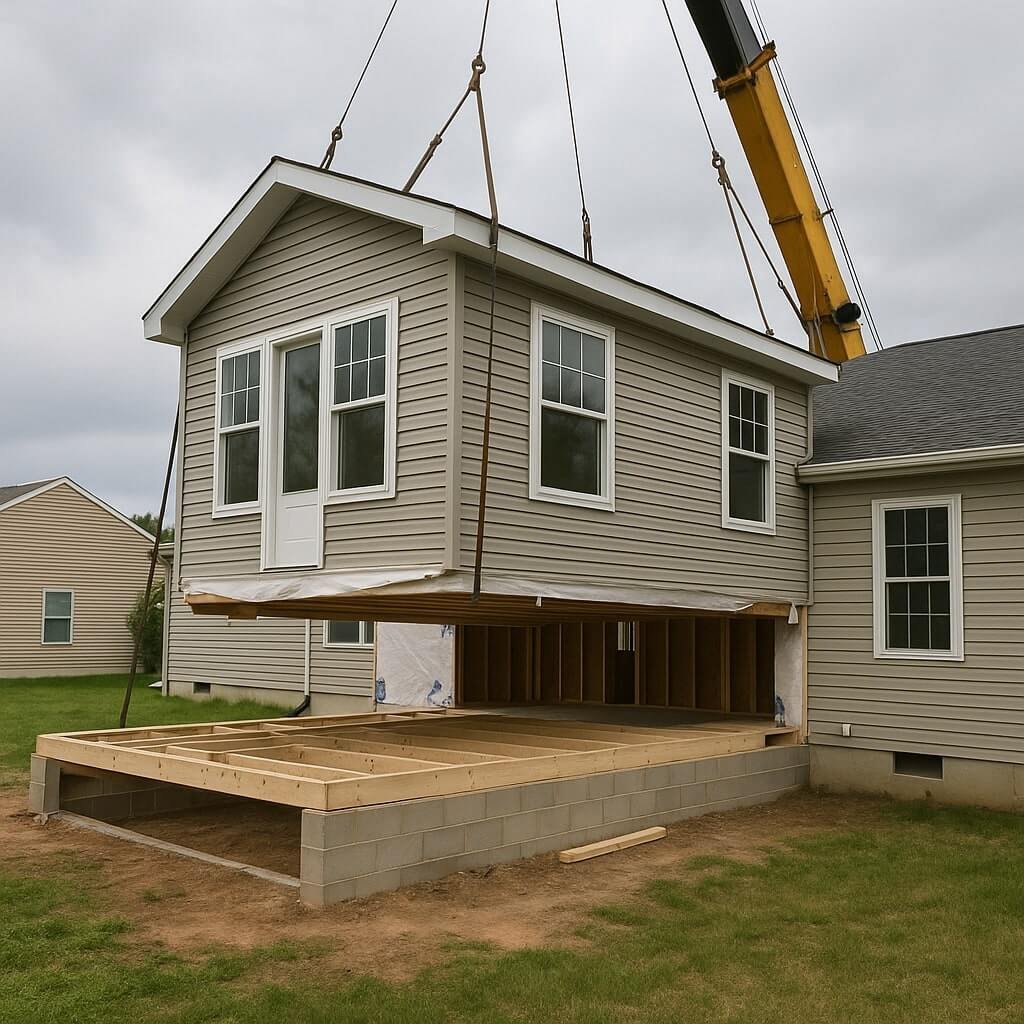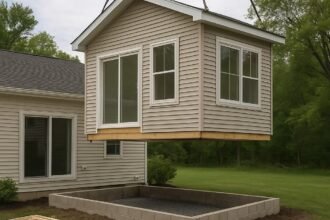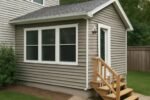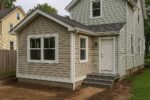When considering the cost of installing prefabricated home additions, you’ll find that several factors come into play. Everything from the design complexity to the choice of materials can greatly affect your budget. Skilled labor rates and local regulations also contribute to overall expenses. Understanding these elements will help you plan effectively. But before you start crunching numbers, it’s important to explore each influencing factor in detail.
Key Takeaways
- Installation costs for prefabricated home additions vary significantly based on design complexity and material choices.
- Labor costs typically range from $50 to $100 per hour, influenced by regional rates and project intricacy.
- Material expenses differ, with wood being more affordable and steel offering greater durability, impacting the overall budget.
- Permits and regulatory fees must be considered, as they can add to the total installation costs depending on local regulations.
- Energy-efficient materials may increase initial costs but can lead to long-term savings on utility bills.
Understanding Prefabricated Home Additions
When you’re considering expanding your living space, understanding prefabricated home additions can make the process smoother and more efficient.
Start by evaluating your design considerations, such as the style and layout that best suits your home. Think about how the addition will integrate with existing structures and your overall aesthetic.
Next, explore material options like wood, steel, or eco-friendly composites, each offering unique benefits regarding durability and appearance.
Factors Influencing Installation Costs
As you plunge into the financial aspects of installing a prefabricated home addition, several key factors will influence the overall costs.
Your choice of design options can greatly affect expenses; more complex designs usually come with higher installation fees.
Design options significantly influence costs; intricate designs typically incur higher installation fees.
Energy efficiency also plays a role—investing in energy-efficient materials and systems might raise upfront costs but can save you money in the long run.
Additionally, local labor rates, site accessibility, and any necessary permits can further impact your budget.
Breakdown of Material Expenses
Understanding the breakdown of material expenses is essential for accurately estimating the total cost of your prefabricated home addition.
You’ll encounter various material types, such as wood, steel, and concrete, each with different price points. For instance, while wood may be more affordable, steel offers durability, influencing your long-term costs.
Conducting cost comparisons among these materials can help you make informed decisions based on your budget and needs.
Don’t forget to factor in additional expenses like insulation, roofing, and siding, as they’ll all impact your overall investment.
Carefully evaluating these elements will guarantee you stay within your financial plan.
Labor Costs for Installation
When considering labor costs for your prefabricated home addition, you’ll want to factor in the rates for skilled labor, which can vary considerably based on region and contractor expertise.
The complexity of your project also plays an essential role; more intricate designs typically require specialized skills, increasing overall labor expenses.
Understanding these variables will help you budget effectively for your installation.
Skilled Labor Rates
Skilled labor rates for installing prefabricated home additions typically range from $50 to $100 per hour, depending on the region and the contractor’s experience. Engaging skilled trades can greatly impact your project’s success, so understanding the labor market is essential. Here’s a quick overview of potential costs:
| Region | Hourly Rate | Experience Level |
|---|---|---|
| Urban Areas | $75 – $100 | Highly Experienced |
| Suburban Areas | $60 – $85 | Moderately Experienced |
| Rural Areas | $50 – $70 | Entry-Level |
Being informed helps you budget effectively for your addition.
Project Complexity Impact
The complexity of your prefabricated home addition can greatly influence labor costs during installation, as more intricate designs require specialized skills and additional time.
When considering design considerations, think about how unique features may demand expert craftsmanship, which can raise labor rates.
Additionally, a complex addition can extend your project timeline, leading to increased overall costs.
Planning for these factors is vital; simple designs typically have lower labor costs and faster installation times.
Permits and Regulatory Fees
Before starting your prefabricated home addition, you’ll need to navigate local building regulations, which can vary considerably by area.
The permit application process typically involves submitting plans and paying fees, so it’s vital to budget for these costs upfront.
Additionally, don’t forget to account for inspection and approval fees, as these are critical steps in ensuring your addition meets safety and compliance standards.
Local Building Regulations
Maneuvering through local building regulations can feel overwhelming, especially when it comes to installing prefabricated home additions.
You’ll need to familiarize yourself with zoning restrictions that dictate where and how you can expand your home. Building codes also play an essential role, ensuring your addition meets safety and structural standards.
Each jurisdiction has its own rules, so it’s important to check with your local authorities before starting. Non-compliance can lead to costly fines or delays.
Permit Application Process
Maneuvering the permit application process is essential for a successful prefabricated home addition.
First, familiarize yourself with local permit requirements, which can vary greatly. You’ll need to gather necessary documents, such as site plans and design specifications, to submit your application.
Keep in mind that the application timeline can range from a few weeks to several months, depending on your location and the complexity of your project. Staying organized and proactive will help you navigate this process smoothly.
If you have questions, don’t hesitate to reach out to your local building department for guidance on specific requirements and timelines.
Inspection and Approval Fees
When planning your prefabricated home addition, it’s important to factor in inspection and approval fees, as these costs can vary considerably by location and project scope.
Here are some key aspects to take into account:
- Inspection Requirements: Verify you understand what inspections are mandatory in your area.
- Approval Timelines: Be aware of how long the approval process typically takes.
- Cost Variability: Fees can differ based on local regulations and project complexity.
- Budget Accordingly: Set aside funds for unforeseen expenses related to inspections or approvals.
Planning ahead can help you avoid surprises and keep your project on track.
Site Preparation and Foundation Expenses
Before proceeding with the installation of a prefabricated home addition, you’ll need to account for site preparation and foundation expenses, which are essential for ensuring a stable and secure structure.
Start with a thorough site assessment to evaluate soil quality and drainage, as these factors influence excavation requirements. Depending on your addition’s size and location, excavation may involve removing soil, rocks, or vegetation, impacting your overall costs.
Additionally, you’ll need to factor in foundation expenses, whether you choose a slab, crawl space, or basement, as each option comes with its own set of requirements and associated costs.
Budgeting Tips for Your Project
How can you effectively manage your budget for a prefabricated home addition? Implementing smart budgeting strategies is key. Here are some cost-saving tips to keep in mind:
- Research Costs: Get multiple quotes from contractors to find competitive pricing.
- Set a Realistic Budget: Include all potential expenses, like permits and materials.
- Prioritize Needs vs. Wants: Focus on essential features first, deferring non-essentials.
- Consider DIY Options: Handle smaller tasks yourself to save on labor costs.
Conclusion
In summary, when planning your prefabricated home addition, it’s essential to evaluate all cost factors, from materials and labor to permits and site preparation. By understanding these elements, you can budget effectively and make informed decisions that align with your vision. Don’t forget to weigh the long-term savings of energy-efficient options against initial costs. With careful planning and research, you can create the additional space you need without breaking the bank.








